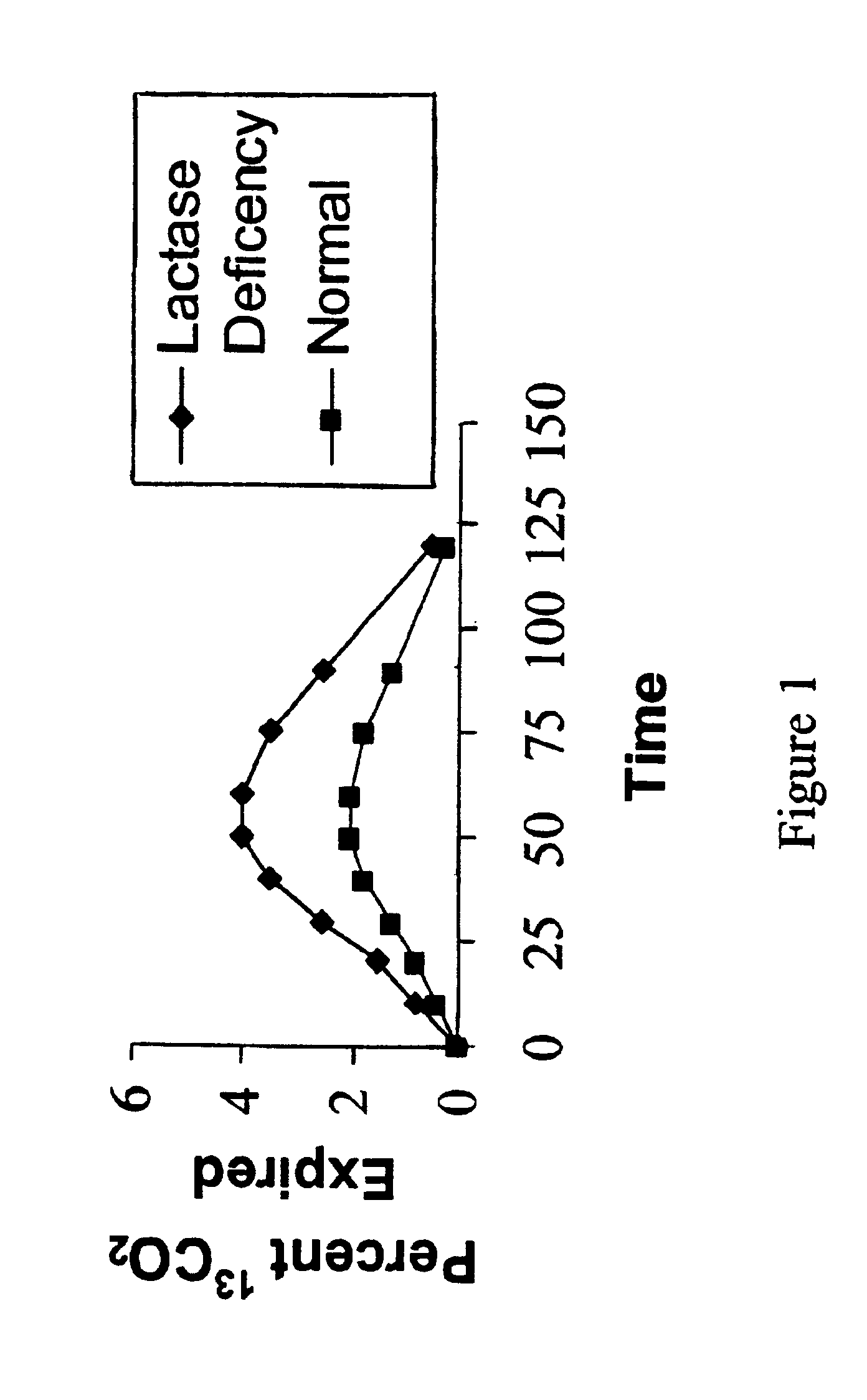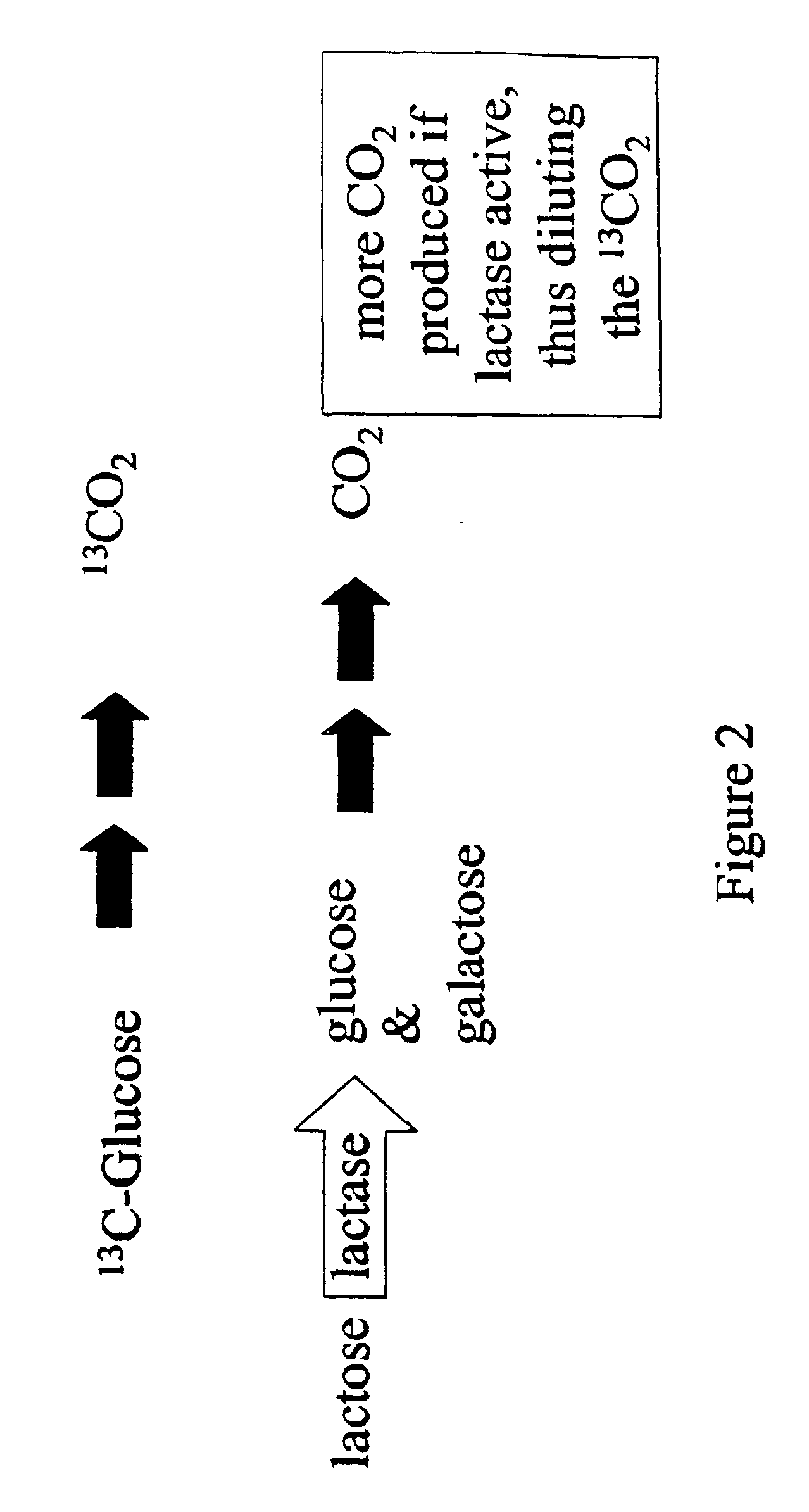Reverse isotope dilution assay and lactose intolerance assay
- Summary
- Abstract
- Description
- Claims
- Application Information
AI Technical Summary
Benefits of technology
Problems solved by technology
Method used
Image
Examples
example 1
Administration of the Test
[0048]All breath tests are performed after a minimum of 8 hours of fasting. Prior to the detection substrate administration, a baseline breath sample is collected using an alveolar gas collection system (QUINTRON GASAMPLER COLLECTION BAG™, QUINTRON INSTRUMENT COMPANY™, Milwaukee, Wis.). Subjects are administered a 10% aqueous lactose solution containing 25 grams of orange-flavored lactose (QUINTRON INSTRUMENT COMPANY™) in 250 ml tap water. In addition to the lactose, subjects consume 100 milligrams of 1-13C-glucose (CAMBRIDGE ISOTOPE LABORATORIES™, Andover, Mass.) which is added to the aqueous lactose solution. End-alveolar breath samples are at evaluated for 13C enrichment in carbon dioxide at 0, 60 and 90 minutes.
example 2
Bicarbonate Measurement
[0049]The amount of 13CO2 in breath storage tubes are measured with a EUROPA SCIENTIFIC™ 20 / 20 gas isotope ratio mass spectrometer (EUROPA SCIENTIFIC™, Cincinnati, Ohio). The ratio of 13CO2 to 12CO2 (mass 45 to 44) is measured in the sample and compared to a reference gas (5% CO2, balance 75% N2, 20% O2). The reference gas is calibrated with international standards. The units of measurement are atom % 13C and defined by:
Atom % 13C=13CO2 / (13CO2+12CO2)*100%
[0050]Standards of carbon dioxide gas at 3 different levels of atom % 13C are run before and after each daily run to check instrument performance. The analytical precision of the instrument is 0.0001 atom % 13C.
[0051]The atom % 13C value of each breath sample is used to calculate the percent of the dose recovered in the breath during each time period. The area under the curve (AUC) for each time period, is calculated by the linear trapezoid method, using the atom % 13C for the two points during time period. Th...
example 3
Test Validity
[0052]Initial investigations established the validity of the test. One hundred twenty (120) subjects (51 males and 69 females) of ages greater than 18 years were evaluated for lactose maldigestion. Each subject was tested on two occasions following an overnight fast. The subject underwent a physical exam and was interviewed concerning their experience with dairy consumption. On Day 1, a 100 mg dose of D-glucose (1-13C, 99%), (CAMBRIDGE ISOTOPE LABORATORIES™, Andover, Mass.) was diluted to with 25 ml with tap water. A 50 g dose of Lactose (QUINTRON, INC.™, Milwaukee Wis.) was simultaneously administered. Breath samples were collected for 13CO2 / 12CO2 ratio measurement were collected at 5, 15, 30, 45, 60, 75, 90, 105 and 120 minutes from dosing. The samples were analyzed on A FINNIGAN BREATHMAT PLUS™ gas isotope ratio analyzer for the 13C / 12C ratio of the exhaled CO2. All of the breath test results were then converted to % dose metabolized per unit time.
[0053]At the same t...
PUM
 Login to View More
Login to View More Abstract
Description
Claims
Application Information
 Login to View More
Login to View More - R&D
- Intellectual Property
- Life Sciences
- Materials
- Tech Scout
- Unparalleled Data Quality
- Higher Quality Content
- 60% Fewer Hallucinations
Browse by: Latest US Patents, China's latest patents, Technical Efficacy Thesaurus, Application Domain, Technology Topic, Popular Technical Reports.
© 2025 PatSnap. All rights reserved.Legal|Privacy policy|Modern Slavery Act Transparency Statement|Sitemap|About US| Contact US: help@patsnap.com



